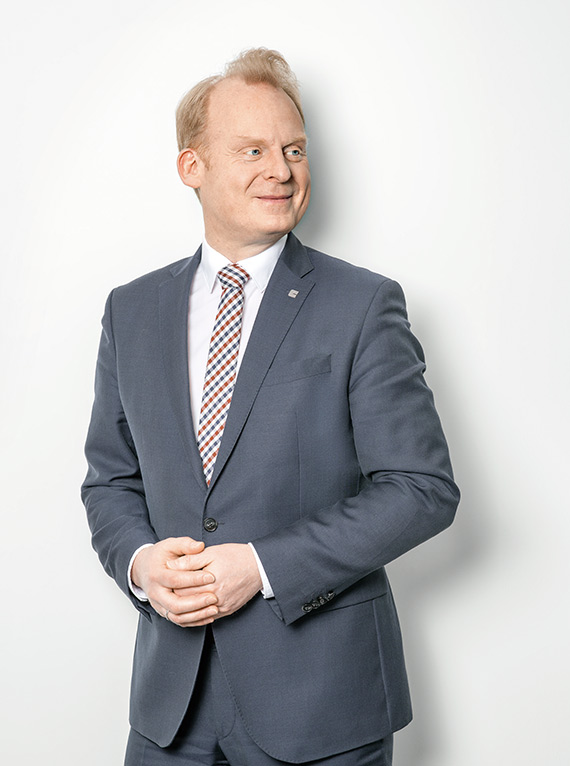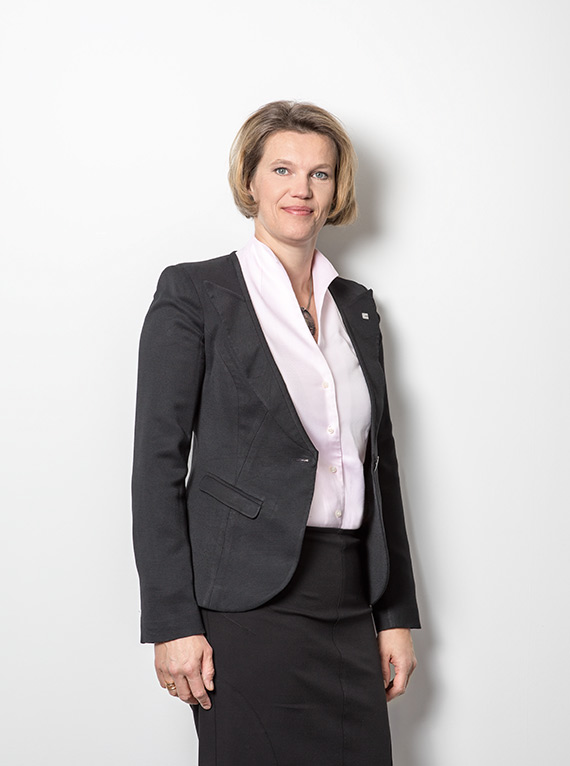Marketing Advances
Harald Dialer, Head of Clariant Excellence, explains how and why Clariant seeks to fundamentally change its approach to marketing.
Mr. Dialer, Clariant has set out to establish a »Leading Marketing Organization«. What does that actually mean?
Harald Dialer: We strongly believe that having the edge in marketing will be a key factor when it comes to our organic growth going forward. That’s why we’re fundamentally rethinking our approach to marketing across all of our Business Units.
What’s wrong with Clariant’s marketing as it is?
As a company we have always been focused on staying ahead of the curve, for example in terms of most efficient processes, our cost positions and especially in innovation and new solutions. Marketing as an institutionalized discipline has not had the same overall strategic focus or impact.

12.3
Recent Marketing Excellence projects led to an added contribution margin of CHF 12.3 million in 2017.
Harald Dialer
Head of Clariant Excellence
What needs to change?
Marketing at Clariant in most cases used to be a scattered service and more of a support function. As such it lacked dedicated resources and clear ownership of the growth pipeline. To put it bluntly, marketing had no seat at the table when it came to strategic decisions. That is about to change – in line with our aspiration to continuously improve and change the way we operate.
Is the problem you’re describing unique to Clariant?
Absolutely not. Most B2B suppliers, especially in the chemical industry, have for decades mostly ignored developments in modern marketing. Understandably so. Our business relies heavily on advanced technology and huge assets. So the belief was: »If we build it, they will come.« And for the most part it worked. But we can do a lot better.
How do you know?
We’re not really starting from scratch. As part of an earlier initiative, we’ve completed well over 50 individual projects in what we termed Marketing Excellence. We did this together with commercial teams across all Business Units. These projects have all been very successful. By most recent estimates, they’ve added CHF 12.3 million of contribution margin in 2017 alone, with an even stronger growth pipeline going forward. The fact that we’ve since been overrun with requests for further projects shows that the Business Units are all eager to further step up their game in marketing. But it also makes sense not to do that on a project-by-project basis. We need to anchor marketing capabilities in the Business Units.

»We’ve generated profitable growth through individual marketing projects. Now we’re anchoring marketing organizationally across all Business Units more deeply to reap even bigger rewards.«
Britta Fuenfstueck Member of the Executive Committee
How do you go about turning marketing into a strategic function?
First of all, by simply establishing dedicated marketing functions that have the necessary empowerment and resources. There will not be sales people doing ten percent marketing on the side. More importantly, we’re putting marketing in the driver’s seat. The management committee of every single Business Unit will have a Head of Marketing either as new member or standing invitee on it.
Why is that important?
Marketing, if done right, delivers customer insights along the value chain that drive and challenge the current strategies of our businesses. Marketing will help us make unique value propositions and identify white spaces in our portfolio where Clariant might excel with new solutions. That will in turn influence how we fill our innovation pipeline. In fact, in some Business Units, such as Functional Minerals, the Head of Marketing will also be the Head of Innovation.
Can you point to success stories where innovation and marketing have gone hand in hand?
In a sense, any successful launch has to be the result of innovation and marketing working closely together. Take VERITRAX™ for example, a groundbreaking combination of digital hardware and software that Clariant launched in 2016. It’s the first intelligent chemical management system of its kind, offering oil and gas producers a fully transparent, automatic solution for chemical control, monitoring and ordering. Clearly, the folks at Clariant who came up with it had a very good idea of what our customers in the industry might need – well beyond our chemical products themselves. They also had the know-how to come up with a solution that’s both pioneering and perfectly practical. To me, that shows how marketing intelligence, a strict customer focus and innovation can create the kind of new and profitable business opportunities that go beyond retention.
What are some of the new functions you’re adding?
We’re adding a whole set of specific functions and methodologies. Differentiating and professionalizing certain tasks is a vital part of this modern approach to marketing. Just as an example, we are hiring specialists in pricing and setting up dedicated teams for marketing intelligence — both functions that, when done right, have a key relevance for profitable growth.
What’s the aim in pricing?
To use all the relevant tools available today and to ensure efficient execution of pricing decisions in the market. Methods of big data-enabled pricing, for example, can help reveal order patterns that correlate to certain price points. This allows predictions about customer behavior and could let us segment our customer base more accurately and proactively instead of just looking back and analyzing who bought what. Marketing intelligence will do the same on a much broader scale. Some of our Business Units operate in markets that we hope to not only understand better, but to also actively shape ourselves. Business Units like Catalysts and Industrial & Consumer Specialties have been doing this in part already. But discerning trends and behaviors both upstream and downstream is becoming more and more relevant to all our operations. The same goes for digital solutions and new business models.
How will your »Leading Marketing Organization« help drive the digital transformation?
New digital channels, e-commerce, track-and-trace logistics, even social networks and what some are calling the »Amazon-ification« of B2B industries all affect how and what we sell. It’s marketing specialists that will help us lead the way on all these fronts.
With these methodologies being fairly new to the chemical industry, are you looking at other industries for guidance?
It’s important that our approach fits the needs of our businesses. There’s never a one-size-fits-all solution. That’s why we’ve worked very hard at tailoring our setup to each and every Business Unit individually in line with the specifics of their industrial environment and global markets. But of course there are other industries that we may learn from. In terms of pricing, airlines and their data-driven dynamic pricing come to mind. We certainly won’t emulate this to the same extent. However, there’s definitely a lot to learn about optimizing capacity utilization and leveraging customer value. In fact, one of our most recent hires is a data specialist who has worked on optimized price-setting methods based on statistical market research techniques and big data in the airline and public transportation sector.
100
The »Leading Marketing Organization« will create approximately 100 additional jobs by 2020.
Speaking of hiring, how many new jobs are you creating in marketing?
We’re currently looking at around a hundred new positions being created through 2020. However, we’re not just adding quantity but also a specific quality of jobs. We’re opening brand new company-wide career paths that just weren’t there before. This is massively important both in order to attract and foster talents in this interesting field.
Where do you find talent?
We’re finding it within Clariant, of course. Part of implementing our »Leading Marketing Organization« is establishing our own Advanced Marketing training courses in order to build the necessary knowledge and expertise. We’re currently evaluating several international business schools and other external partners to design a tailored curriculum for our employees together with the Clariant Academy. But we’re obviously also seeking and hiring specialists from outside Clariant and from other industries, as I mentioned.
What’s the biggest challenge going forward?
The scope of implementing a new common methodology across the whole company is daunting. As is the fact that we’re often simultaneously outlining, implementing and filling so many new positions. However, we’re carried by the Business Units, who all see the benefit. There’s no doubt that these are interesting times to be working in sales and marketing at Clariant.
Clariant Excellence is an initiative launched in March 2009 with the aim of establishing a culture of continuous improvement. The initiative is based on a change in mindset among all employees and at all levels of the company. It aims to improve competitiveness through gains in efficiency and to create added value. The four elements of Clariant Excellence are: Operational, Commercial, People, and Innovation Excellence. VIEW ENTIRE GLOSSARY
The value chain describes the series of steps in the production process, from raw materials through the various intermediate stages to the finished end product. VIEW ENTIRE GLOSSARY
A substance that lowers the activation energy, thereby increasing the rate of a chemical reaction without being consumed by the reaction itself (Clariant Business Unit Catalysts). VIEW ENTIRE GLOSSARY